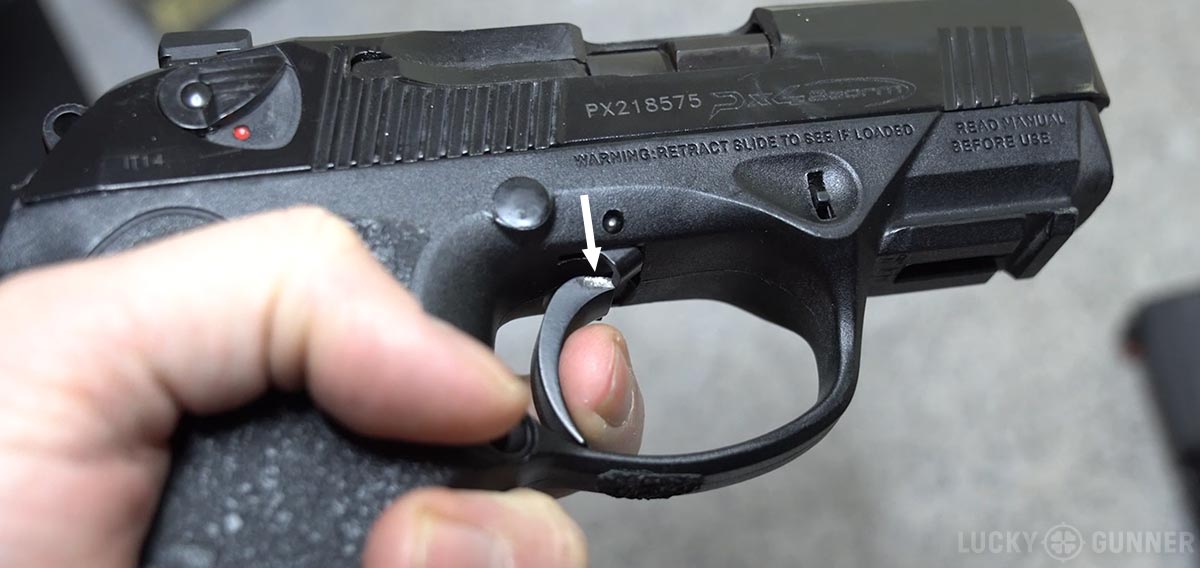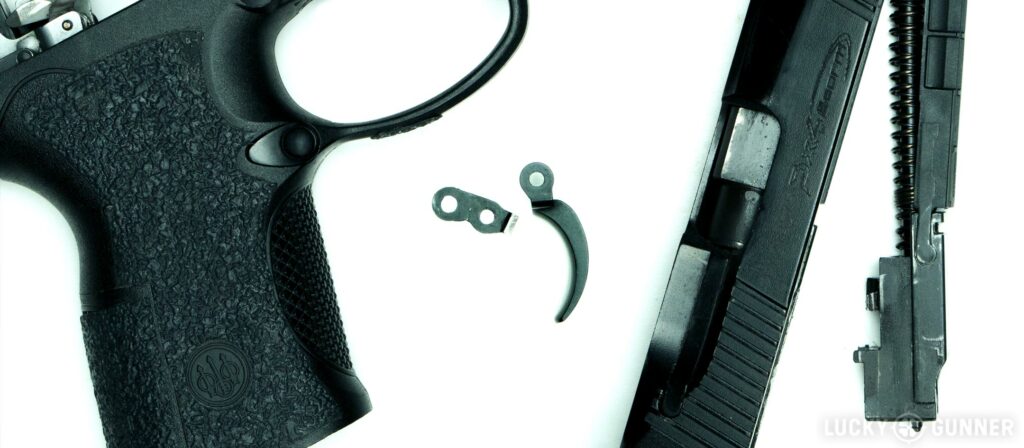After yet another handgun parts breakage, I wanted to share some tips about how to avoid running into reliability issues with your defensive firearms when it matters most. Details in the video below, or scroll down for the full transcript.
A few weeks ago, I shared a video about my Ruger GP100 Match Champion that had stopped working. I used that as an opportunity to talk about the importance of testing the reliability of your self-defense guns and how you can’t take anything for granted — that any gun can break no matter what the brand or what type of gun it is. Well, since then, I’ve had another gun give me some serious problems. I’m not going to rehash all the things I went over last time, but I do have a few other thoughts relating to the reliability of these guns that we depend on as life-saving equipment.
In this case, the gun I had a problem with is my Beretta PX4 Compact. This gun has been extremely reliable. I don’t have an exact round count, I lost track of that, but I’m pretty close to about 9000 rounds through this gun with only two issues. I had two ejection failures within about 100 rounds of each other when the gun was under-lubed. Other than that it, has run flawlessly… until a couple of weeks ago. I was in a two-day handgun class and after the first day, I took the gun back to the hotel room and I was doing a little dry practice and the trigger started to feel kind of weird, like it wasn’t resetting properly. So I dry fired it a couple more times and it just went “snap.” this little leg on the trigger that connects the trigger to the rest of the action had just kind of snapped, giving me a dead trigger and, basically, a useless gun.

The trigger that broke is actually not a Beretta part, it’s an aftermarket part. So I don’t hold this against the gun itself — I still think the PX4 is a fantastic weapon and I wouldn’t hesitate to recommend it to anybody. But it does bring up a couple of other issues I wanted to talk about. First, if you’re going to a shooting class, always take a backup with you. This gun breaking was not really a huge deal for me because I also brought this along with me: a PX4 Compact Carry with an almost identical setup to my PX4 Compact. So, all I had to do was just stick the other gun in my holster in the morning and I was ready to go. If you’re going to have a problem with a gun, it almost always seems to come up during a class when you’re shooting a lot of rounds in a compressed time period. You don’t want to have to finish out the class with a borrowed gun, that’s no fun. Bring a second gun with you.
Another important lesson here is that you should always be very reluctant to trust aftermarket parts. A lot of problems we have with handguns can be traced back to aftermarket parts, whether it’s magazines or triggers or action parts. Any of that stuff can seriously impede the function of the weapon. We see this a lot with Glocks in particular. There are a lot of different Glock triggers out there. There are some good ones and there are some really bad ones that can cause the gun to not work or to become really unsafe. So be careful with that stuff. Don’t be the beta tester or the guinea pig for a company that’s making aftermarket parts. Talk to people who know the gun that you’re going to be carrying and understand how it works and ask them what parts are good and which parts are not recommended.
In this particular case, I didn’t actually know that this trigger was an aftermarket part. This was being sold on the Beretta website. It’s a trigger that is functionally identical to the factory trigger except it’s metal and the factory trigger is plastic. I just stuck it in the gun to see if it would make any difference in how the trigger felt. It didn’t really feel any different so I just left it in there. What I didn’t know is that Beretta doesn’t actually make it. I found that out after the trigger broke and I also found out that they are prone to breaking. I’m not the only one who has had an issue, so hopefully, now that Beretta knows about the problem, they will stop selling the metal trigger or they will make sure the problem gets fixed. But usually, it’s clear who’s making the parts that go in your gun, and if it’s made by anyone other than the company who made the gun itself, I would eye it with some skepticism before you trust your life to it.
One more thing I wanted to mention is a suggestion I heard from Tom Givens a few years ago. And that’s the idea that if you’re shooting your self-defense gun a couple thousands rounds a year or more, it’s probably not a bad idea to buy a second gun that’s identical to that gun so you have a designated carry gun and a designated training gun. The training gun is the one you take to the range and you do all your dry practice with it. And the carry gun, you might test fire it occasionally, but you kind of try to keep the miles off of it. And the idea is that all of these guns are going to fail eventually and we don’t know when. If they’re good quality guns with good quality parts in them, then hopefully they won’t fail for a long time, but you never really know. There are always those crazy outliers where something just spontaneously breaks. So if you’re shooting the gun a lot, you’re kind of getting it closer to that failure point. If you carry a gun that you’re not shooting a whole lot and you’re protecting it, you’re keeping the miles off of it so you can rely on it to work if you ever need it. It’s really disconcerting to show up at the range with your carry gun in your holster and you pull it out and go to fire it and it doesn’t work. Or you go through a couple of rounds and something breaks. I’ve had that happen before and it’s not a good feeling.
This principle is not something I have practiced myself until fairly recently. I shoot a lot of different guns and I’m switching often depending on what I’m evaluating or reviewing, but earlier this year, I just decided I’m going to stick with the PX4 Compact. It’s worked really well for me. It may not be the perfect gun and I might find something I like better down the road, but I shoot it really well and it’s really reliable and I’m kind of holding myself back in terms of skill development by switching around a whole lot. So I’m just going to shoot the PX4 for a while and see how far I can get myself skill-wise. During that time, I’m going to have a designated training gun and a designated carry gun so I don’t run into one of those issues where I have the trigger break while I’m carrying the gun. I’m going to use the training gun for that kind of experimentation and protect the carry gun. Of course, I’ll still be reviewing guns and shooting other guns, but I might not put quite as many rounds through our test guns as I have in the past. This might not be something you have to worry about if you’re not shooting a ton but if you’re really serious about your training and you’re putting a lot of rounds through your defensive guns, it’s not a bad idea to consider adding some redundancy to your carry gear.
This is probably the last video I will post in 2017. I’m going to take a couple of weeks off for Christmas, but I’ve got a lot of stuff coming up next year that I’m really excited about. We’re going to be doing some low light stuff. We’re going to be testing a bunch of different quick-access gun safes. I’ve got a series in the works all about pocket pistols. We’re going to have more ballistic gel test results. And for those of you who have been asking, there will be a full review of the Beretta PX4 Compact Carry. So keep an eye out for that and more in early 2018. In the meantime, of course you can still buy ammo from us at Lucky Gunner. We’ve got all the most popular brands with lighting-fast shipping. If you place an order by 3PM Eastern on a business day, we will get your order out that same day. So if you’ve got any last-minute Christmas shopping to do, that might be something to think about.
Guys, thanks for following us and for all of your support in 2017. I hope you have a great Christmas and a good New Year, and I will see you in January!

